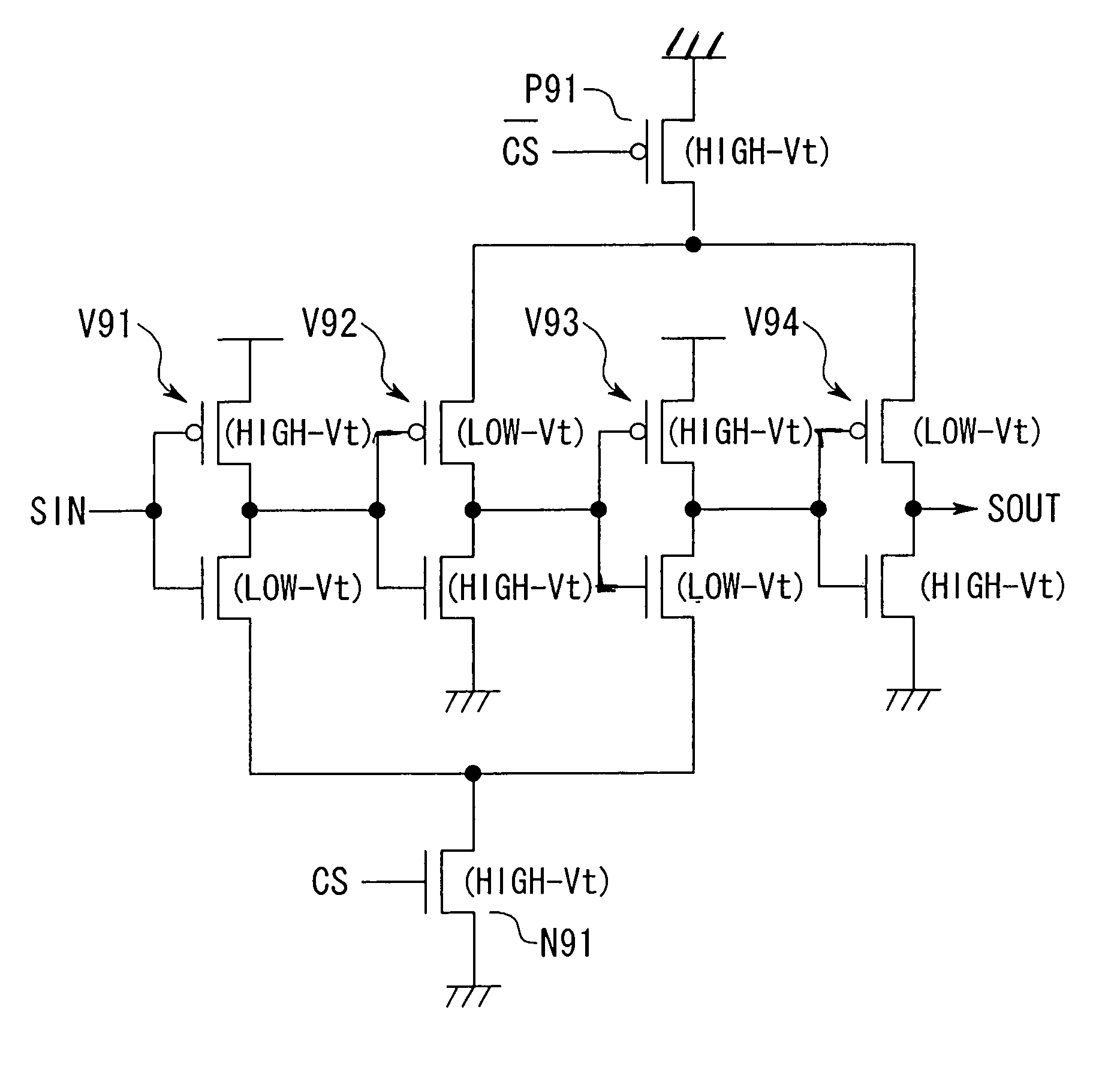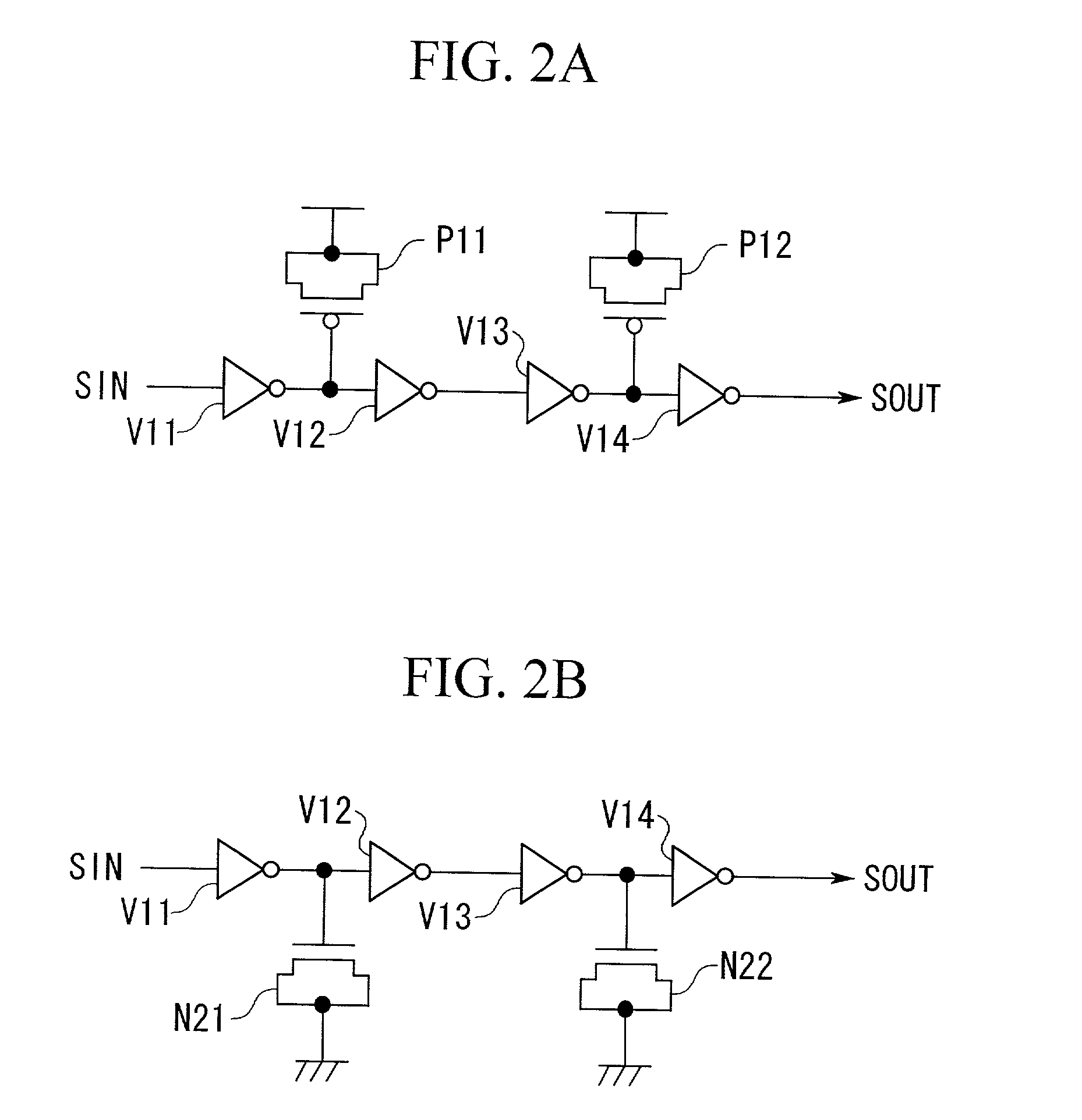Delay circuit and method
a delay circuit and delay technology, applied in the field of delay circuit and method, can solve the problems of delay in the signal that passes through the delay circuit and the inability to satisfy the timing relationship for every signal, and achieve the effect of suppressing the delay time and not increasing the delay time excessively
- Summary
- Abstract
- Description
- Claims
- Application Information
AI Technical Summary
Benefits of technology
Problems solved by technology
Method used
Image
Examples
embodiment 1
[0048]FIG. 1A shows a delay circuit in Embodiment 1.
[0049]This delay circuit is designed to output signal OUT by delaying a logic signal SIN that has two logic levels consisting of low level and high level, and exhibits a characteristic that the delay time for a logic signal input at the high level is different than a logic signal input at the low level, so that the delay circuit is comprised of a delaying system such that, of the two logic levels (low and high logic levels) given as the logic levels of the logic signal SIN, the logic level targeted for delay is the one having a shorter delay time. In the example shown in the diagram, the high level of the logic signal SIN is the delay target so that the logic signal SIN is delayed when the logic signal SIN changes from the low level to the high level.
[0050]The structure of the delay circuit will be explained in the following.
[0051]As shown in FIG. 1A, this delay circuit is comprised by an inverter chain that includes inverters V11˜...
embodiment 2
[0067]Embodiment 2 will be explained in the following.
[0068]FIG. 2 shows a structure of a delay circuit in Embodiment 2.
[0069]In Embodiment 1 described above, the delay circuit depends on a MOS capacitor comprised by a p-MOS transistor in the output section of an inverter whose output signal changes from the high level to the low level according to the nature of a logic signal SIN, and on an n-MOS capacitor comprised by an n-MOS transistor in the output section of an inverter whose output signal changes from the low level to the high level, but in Embodiment 2, an MOS capacitor is provided in either the output section of an inverter whose output signal changes from the high level to the low level or the output section of an inverter whose output signal changes from the low level to the high level according to the nature of a logic signal SIN.
[0070]FIG. 2 shows an example of the structure of the delay circuit in Embodiment 2.
[0071]The example shown in FIG. 2A, n-MOS transistors N11, ...
embodiment 3
[0075]Embodiment 3 will be explained in the following.
[0076]FIG. 3 shows a structure of a delay circuit in Embodiment 3.
[0077]In the example shown in the diagram, p-MOS transistors P11, P12 shown in FIG. 1A to serve as the MOS capacitors are replaced with n-MOS transistors N31, N32 of high-Vt, and n-MOS transistors N11, N12 are replaced with p-MOS transistors 31, P32 of high-Vt.
[0078]Here, the drain and source of n-MOS transistors N31 are connected in common to the output section of the inverter V11, and the drain and source of n-MOS transistor N32 are connected to the output section of the inverter V13, and the gate terminals of n-MOS transistors N31, N32 are both fixed at the source voltage VDD. Also, the drain and source of p-MOS transistor P31 are connected to the output section of the inverter V12, and the drain and source of p-MOS transistor P32 are connected to the output section of the inverter V14, and the gate terminals of the p-MOS transistors P31, P32 are both fixed at t...
PUM
 Login to View More
Login to View More Abstract
Description
Claims
Application Information
 Login to View More
Login to View More - R&D
- Intellectual Property
- Life Sciences
- Materials
- Tech Scout
- Unparalleled Data Quality
- Higher Quality Content
- 60% Fewer Hallucinations
Browse by: Latest US Patents, China's latest patents, Technical Efficacy Thesaurus, Application Domain, Technology Topic, Popular Technical Reports.
© 2025 PatSnap. All rights reserved.Legal|Privacy policy|Modern Slavery Act Transparency Statement|Sitemap|About US| Contact US: help@patsnap.com



